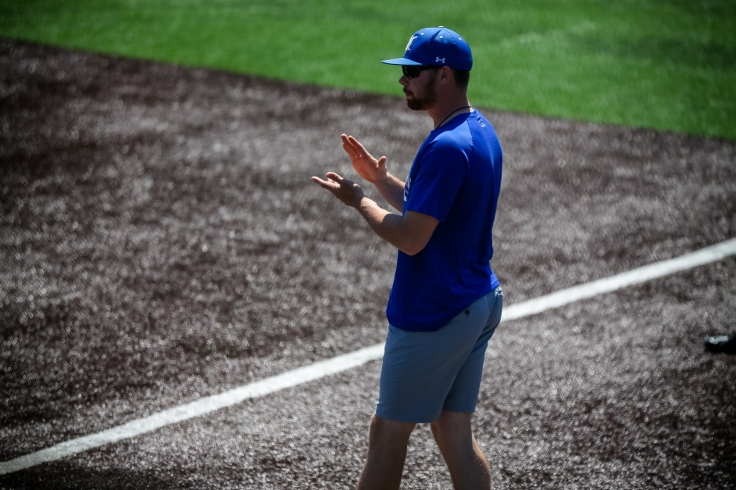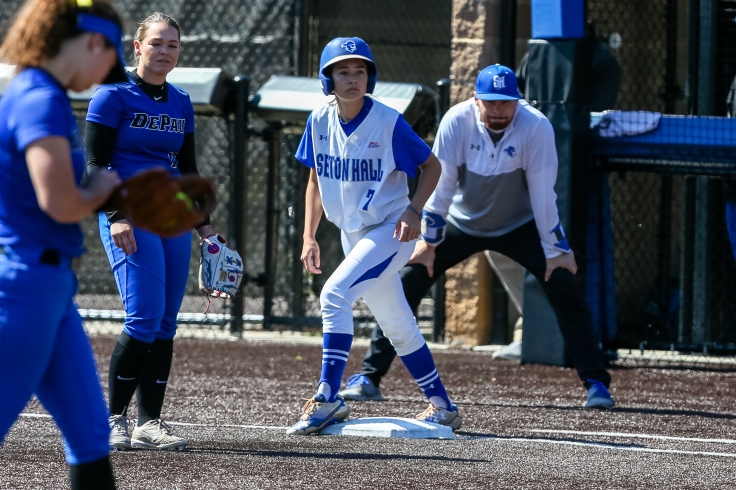Nick Santoriello @NickSantoriello
10/10/18
“It’s called rugbrød.”
Walking into Daniel Nicolaisen’s office seems like a normal enough work space; an open laptop, a few loose sheets of paper, and the smell of coffee from his morning Starbucks. Moving along the soft carpet in the office one cannot help but notice the big whiteboard above Nicolaisen’s desk with names and numbers written in black marker. On it are words like speed, sleep, and percentage.
This board is an open window into what Nicolaisen is trying to accomplish at Seton Hall.
Daniel Nicolaisen is in his first year as the assistant coach for Seton Hall softball. Nicolaisen served as a volunteer coach for the Pirates during the 2018 season but is now back in a bigger role.
With him, Nicolaisen has brought a whole new system for evaluating and coaching hitters: Blast Motion. The Blast Motion program uses a tiny sensor placed on the end of each bat that detects a multitude of analytical measurables such as bat speed, attack angle, and body rotation.
“We’re taking a more ecological approach meaning we take the environment into consideration when we’re practicing,” Nicolaisen said. “We’re making sure the environment is right and we track performance data objectively. Then we prescribe practice plans off that and what we see.”
Finally sitting down at Nicolaisen’s desk, one is fully-immersed in the world of data-driven coaching.
There is a book on kinesiology on the far shelf. On the laptop are spreadsheets filled with data on every player with color codes and graphics to represent good or bad results. And then there is Nicolaisen staring intently at the numbers that could drive an accountant crazy.
With this information, the former softball player pours through countless spreadsheets of numbers to help address and correct any problems that may arise in a player’s swing; a practice few other collegiate softball programs utilize.
SHU Sports Focus: Where are you from originally?
Daniel Nicolaisen: Denmark. I’m like 20 minutes outside of Copenhagen.
SSF: What’s the biggest difference between living in Denmark and the US?
DN: Probably the social aspect. Everything over here is a little bit more spread out and Denmark has a little bit more going on culturally.

SSF: What’s your favorite Danish food?
DN: The classic one is a rye bread open faced sandwich. It’s called rugbrød.
SSF: How did you get your start in coaching?
DN: When I was 14 or 15 I started working in the Danish Softball Federation and taught [Physical Education] classes where you have to teach softball from scratch. I was coaching the younger teams in the club I played for back home. When I came over to America to play baseball, I started doing lessons.
SSF: So, you played fastpitch softball your whole life but played baseball in college. What was that transition like?
DN: That was hard. That was really challenging. It took a couple years until I somewhat figured it out, but I never fully did.
SSF: If you didn’t play softball or baseball, what, if any, sport would you play?
DN: European style handball.
SSF: You talked about prescribing drills. Would you consider yourself a sort of “Softball Statistical Doctor”?
DN: I wouldn’t say doctor at all. At all. I’m only scratching the surface of what other people are doing.
SSF: Well if you’re not a doctor do at least have any kind of hidden talents?
DN: I’m good at cooking. I’ll cook. I don’t think anybody knows that here.
SSF: Funny you mention that because we’ll get to more food later, but what’s the most challenging part of keeping all these numbers together and organized?
DN: The most challenging part is putting the system in place. From there on out we just have to plug it in and it takes care of itself.
SSF: What kind of feedback from your players have you received since implementing this system?
DN: You can definitely tell they’re excited that they’re getting constant feedback. I told them from the beginning it’s not going to be super-visual. It’s not going to be all in your face but when we make decisions, we have something objectively behind it. We have a reason why we’re doing things.
SSF: Have you tested any of this equipment on yourself?
DN: Yeah, I mean I messed around with it all summer.
SSF: How did that go?
DN: It went well. The main thing I figured out was how important the environment was. So when I’m hitting off a tee my metrics are going to be different from when I’m hitting front-toss and live-batting.
SSF: And finally, back to food. What’s your go to ballpark grub?
DN: Burgers.
SSF: Cheese or no cheese?
DN: Definitely cheese. I will get a burger pretty much anywhere we go.
SSF: This is not about burgers but do you consider a hot dog to be a sandwich?
DN: No. There’s no reasoning behind it but I just feel like it’s not a sandwich. It’s a separate category.

SSF: What’s your goal for the team moving forward with this statistical analysis?
DN: It’s to continue to stay engaged. We talk about the process a lot. We just have to keep up with it and I think the results will take care of themselves.


Leave a comment